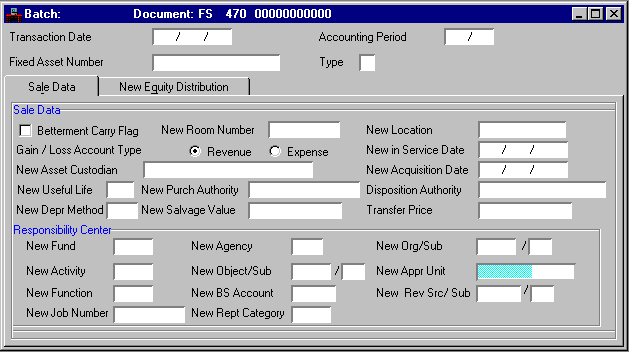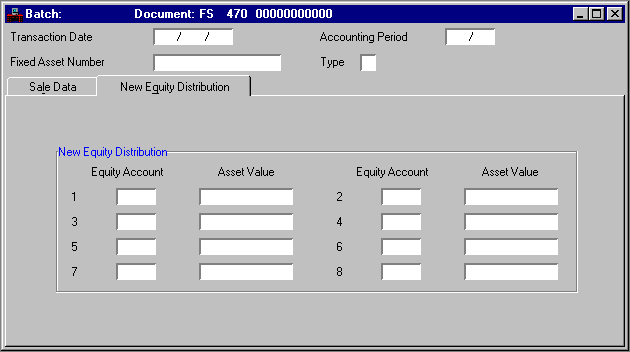|
|
|
Sale Data
|
|
Betterment Carry Flag
|
Default is cleared
[N]
. Select
[Y]
if the betterment records associated with this asset are not deleted. All amount fields on these records; however, are set to zero. Otherwise, leave cleared
[N]
so the betterment records associated with this asset are deleted.
|
|
New Room Number
|
Optional. Enter the room number associated with the fixed assets.
|
|
New Location
|
Required. Enter the new location of the fixed asset. See Fixed Asset Location Inquiry (FALC) for valid values.
|
|
Gain/Loss Account Type
|
Defaults to
Revenue [blank]
.
Expense [E]
is only valid if the selling fund is proprietary. Select
Expense [E]
if the gain/loss is posted to an expense account in
Gain/Loss Account/Object
on System Special Accounts (SPEC).
|
|
New in Service Date
|
Optional. Enter the new in-service date (
mm dd ccyy
).
|
|
New Asset Custodian
|
Optional. Enter the employee's name or the position number. If left blank, this field defaults to "None."
|
|
New Acquisition Date
|
Required. Enter the new date (
mm dd ccyy
) of acquisition for this fixed asset.
|
|
New Useful Life
|
Conditional. Required if a Depreciation Indicator in FATP is set to [Y]; otherwise, leave it blank. For a fixed asset with a type of
L
(land)
or
C
(construction), leave this field blank. Enter the useful life of the fixed asset. This number is used by the depreciation process.
|
|
New Purch Authority
|
Required. Enter the purchase order number used to purchase the fixed asset.
|
|
Disposition Authority
|
Required. Enter the disposition authorization from the old owner.
|
|
New Depr Method
|
Conditional. Required if a Depreciation Indicator in FATP is set to [Y] - the default is 'Straight Line'; otherwise, leave it blank. For a fixed asset with a type of
L
(land) or
C
(construction), leave this field blank. Enter the depreciation method that is used by the depreciation process. Valid values are:
SL
Straight line
SY
Sum of the years digits
DD
Double declining balance
MC
Manually computed
NA
Not applicable. If this field is blank, this field defaults to
NA
.
nnn
where
nnn
is a declining balance rate (for example, 200 for a double declining balance rate).
|
|
New Salvage Value
|
Optional. For a fixed asset with a type of
L
(land) or
C
(construction), leave this field blank. Enter the salvage value of the asset. This number is used by the depreciation process.
|
|
Transfer Price
|
Required. Enter the selling or transfer price of the fixed asset. Ensure that it is equal to the sum of the asset values at the bottom of this screen.
|
Responsibility Center
|
|
|
New Fund
|
Required. Enter the appropriate proprietary or governmental fund. If this is a modification to a previously entered document, fund is inferred from the original document. See Fund Index (FUND) for valid values.
|
|
New Agency
|
Required. Enter the agency that is primarily responsible for the fixed asset. See Agency Index (AGCY) for valid values.
|
|
New Org/Sub
|
Required. The agency/organization/fiscal year combination must exist on Organization (ORG2). Sub-Organization can only be entered if Organization is entered; otherwise it is blank. See Sub-Organization (SORG) for valid values.
|
|
New Activity
|
Optional. Enter the activity that is primarily associated with the fixed asset. See Activity Index (ACTV) for valid values.
|
|
New Object/Sub
|
Enter the object code on the internal sale, otherwise leave blank. When Object is entered, Rev Srce and BS Acct must be blank. See Object (OBJ2) for valid values. Sub-Object can only be entered if Object is entered; otherwise it is blank. See Sub-Object (SOBJ) for valid values.
|
|
New Appr Unit
|
Required. Enter the Program Budget Unit element for the items listed on this voucher. See Program Reference Table (PRFT) for valid values. The Appropriation Program element and Allotment Program element will be inferred from PRFT based on Program Budget Unit.
|
|
New Function
|
Optional. See Function (FUNC) for valid values. If left blank, it is inferred from Organization (ORG2); or from Activity (ACT2), if a function code is not entered on Organization (ORG2).
|
|
New BS Account
|
Conditional. Enter a balance sheet account if this is an expense transaction (fixed assets) or if this transaction transfers funds between two balance sheet accounts.
If the latter is the case, Object must be blank. See Balance Sheet Account Index (BACC) for valid values. You cannot enter a balance sheet account that is used as a default account on System Special accounts (SPEC). However, you can enter the default fund balance account.
|
|
New Rev Srce/ Sub
|
Conditional. Enter a revenue source on an internal refund transaction; otherwise, leave blank. When revenue source is entered, Object and Balance Sheet Account must be blank. See Revenue Source Index (RSRC) for valid values.
Enter a sub-revenue source if Revenue Source is entered and Sub-Revenue Source Required is Yes [Y] on Revenue Source (RSR2). If Sub-Revenue Source Required is No [N], sub-revenue source is optional. See Sub-Revenue Source (SREV) for valid values.
|
|
New Job Number
|
Conditional. Organizations and activities can be defined to require the entry of a job number. Refer to Organization (ORG2) or Activity (ACT2) for details.
Otherwise, this field is optional. If
Job Cost
is
Yes [Y]
on System Control Options (SOP2), enter a job number. See Job Index (JOBT) for valid values. If
Job Cost
is
No [N]
on System Control Options (SOP2), enter a project number or general reporting category.
|
|
New Rept Category
|
Conditional. This field required on expenditure transactions if Reporting Category on Agency (AGC2) is Required on Expenditure Transactions [3].
This field is required on revenue transactions if Reporting Category Required on Revenue Transactions is Required [Y]. For transactions that require a balance sheet account code, this field is required if Reporting Category Option is Y (required) on Balance Sheet Account Index (BACC). Otherwise, this field is optional. See Reporting Category (RPTG) for valid values.
|





